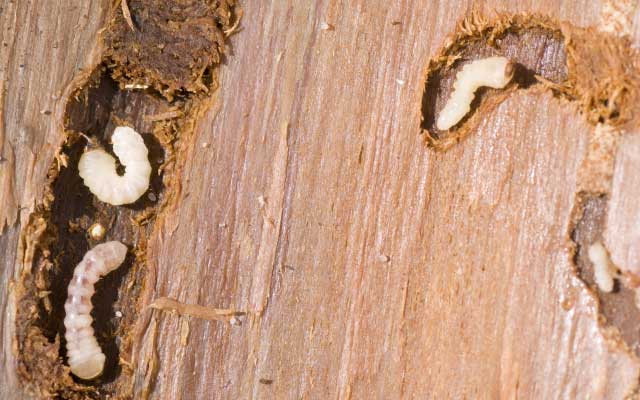
What is woodworm?
Woodworm is the wood-eating larvae of certain species of beetle. It can be a cause of timber decay and subsequent structural damage, especially on properties built with a timber frame. Woodworm can also affect wooden furniture.
Woodworm damage happens when the beetle eggs hatch and the larvae eat into the wood, forming tunnels and chambers from which an adult beetle will eventually emerge. It is these voids that can weaken the timber.
Signs of woodworm
You can spot signs of woodworm by checking floor joists, floorboards and also wooden furniture for:
- Small piles of dust underneath the infected timber, created by larvae as they bore into wood.
- Tiny exit holes in the timber. Woodworm holes in furniture are an obvious sign of infestation.
- Weak floor boards and joists, though such damage could be due to other reasons.
- Live beetles appearing around your home, especially in rooms with wooden furniture and timber framing.
- Dead beetles, a sign they've managed to mature and die.
- Eggs, although these are hard to spot with the naked eye.
- Woodworm larvae, sometimes called wood grub and usually a creamy-white colour.
How can I get woodworm?
Wood-boring insects are attracted to buildings suffering from damp or rooms with a high relative humidity or condensation. Such conditions will affect the moisture content of the timber in the structure, and moisture over 16% persisting for 1 or 2 years is a risk.
So check for leaks inside and out, as well as making sure you have proper ventilation and insulation in your home. Otherwise damp timber and timber decay will encourage wood-boring insects to lay eggs.
How do I get rid of woodworm?
While most older properties, pre 1945, may have had some woodworm in the past, the advent of central heating and modern building regulations have largely removed the conditions whereby woodworm is a risk.
However, the owners of older buildings may still need to do some necessary home improvements, and listed buildings will require especial care.
Preventing woodworm
The best thing you can do is prevent woodworm from happening in the first place. The steps can include:
- Keeping the moisture content of timbers below 15%.
- Ventilating and heating your home.
- Checking any period furniture you bring into your home for signs of woodworm. If necessary, make sure it's been treated to drive out any remaining larvae.
And lastly, don't evict your spiders – they have an appetite for the larvae.
Woodworm treatments
The use of chemicals should be a last resort in the removal of active woodworm. Improving the home environment is a cheaper and probably more effective course of action, with an eye to keeping up maintenance, for instance gutters. Controlling the relative humidity inside your home is another quick win.
Beware, oak beams and joists in old houses may look worm-eaten, but the resilient heartwood can often be quite sound. And Victorian softwood floorboards that have suffered in the past may be just as sturdy. It's a good idea to avoid carpet underlays that can trap moisture in the boards.
But if timbers have been severely attacked over many years, then replacement may be the best option.
Can I claim for woodworm on my home insurance?
Woodworm is not generally covered by home insurance. It's sometimes listed as an exclusion, or considered by insurers as gradual deterioration, or unavoidable wear and tear. Check with your insurer whether woodworm is covered by your buildings insurance policy.
Published 14 September 2020
Author: Jim Hunt
